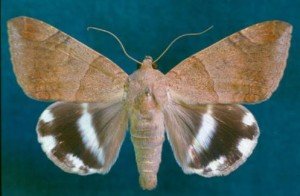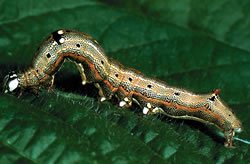Over the past week we have had several enquiries about large numbers of caterpillars destroying plants in home gardens. This pest has now been identified as castor oil looper – Achaea janata. While the entomology team does not generally report on home garden issues, this pest can also affect broadleaf crops such as soybeans and mungbeans.
The castor oil looper is a minor and sporadic pest but larger outbreaks are possible in some seasons. Large flights of castor oil looper moths have been reported over Southern Queensland during March.
Identification of castor oil looper
The mature castor oil looper is purple-brown, has both light and dark forms and has two conspicuous black spots on the back behind the front legs. Loopers are up to 60 mm long and in addition to 3 pairs of true legs, also have four pairs of prolegs towards the rear of the body. Their body tapers noticeably towards the head. Loopers, as their name indicates, move with a distinctive looping action.

Lifecycle
Little is currently known of the lifecycle of castor oil loopers. The egg stage is estimated to last about 5 days, with the caterpillar (looper) stage taking about four weeks and the pupal stage lasting about 10 days. Unlike Helicoverpa which pupate in the soil, looper larvae usually pupate on the plant under leaves in a thin silken cocoon.
Damage
Loopers are mainly leaf feeders but can occasionally feed on seed. Larger caterpillars can consume whole leaves and large infestations can cause severe defoliation.
Management
Loopers are easily controlled with biopesticides such as Bt (e.g. Dipel) when they are small. Regular inspection, at all crop stages, is necessary to detect infestations early so as to enable control measures to be applied before serious damage is done.
Loopers are attacked by numerous predators and parasites. Many of these also attack Helicoverpa (e.g. predatory bugs, tachinid flies, braconid wasps and ichneumonid wasps). Loopers are frequently parasitised by small wasps (Apantales sp.) with scores of parasite larva developing per looper host. The use of Bt for looper control will help preserve beneficial insects and also reduce the risk of subsequent whitefly and mite attack.
Outbreaks of looper viruses are frequently observed in crops with high looper populations. However, larvae are usually not killed by virus until they are a medium-large stage (instars 4-5). Looper virus is not the same as Helicoverpa nuclear polyhedrosis virus (NPV). Application of NPV (e.g. VivusMax) will not control loopers.
Other caterpillar pests
We have received a few reports of caterpillar infestations in pastures. Without specimens or good quality photos the entomology team is not able to identify these pests. If you have any concerns about pests in crops or pastures please forward photos or samples of the pests to Zara Ludgate at DEEDI, PO Box 102, Toowoomba 4350 Qld or send images to [email protected]
Article by Kate Charleston

